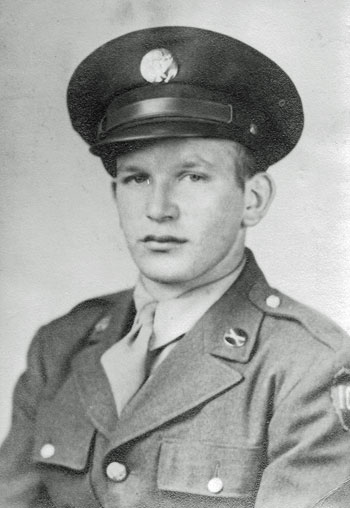 |
134th Infantry Regiment"All Hell Can't Stop Us" |
 |
 |
134th Infantry Regiment"All Hell Can't Stop Us" |
 |

Walter J. Kranz was born on August 24, 1922 in Riverside N.J. and attended high school there. He entered the service on December 12, 1942. He was a Private 1st Class with Company L, 3rd Battalion, 134th Infantry Regiment, 35th Infantry Division "Santa Fe". He was Killed in Action on November 13, 1944 near Bellange, France. He is buried at St. Peters Cemetery in Riverside N.J.
| November 13 was a
day to be remembered in the 3rd Battalion as "Blue Monday" on
Red Hill; in the 2nd Battalion it would never be forgotten
for one of the greatest battles in that unit's operations - Achain; and
the 1st Battalion found it memorable for its difficult attack
against Pevange. Cold, damp weather had prevailed almost continuously since the opening of the offensive, but there was an even more noticeable chill in the wind this evening, and infantrymen sought protection, not only from the enemy's fire, but from the weather's blast as well. The season's first snow blanketed the whole landscape in its full whiteness as a gray dawn broke and men of the 134th prepared to move toward objectives which loomed more formidable than any they had encountered all week. Rougemont, or Red Hill, was a high, dominating terrain feature whose capture seemed to be the key to the whole situation. There was some brush on its slopes, but the top largely was bald. One platoon of Company L had taken a forward position on a small hill which rose on the left as part of the same ridgeline of which the big hill was also a part. That platoon's diversionary fire apparently directed German attention in that direction while the remainder of Company L and Company K moved forward over what should have been the more difficult approach - down across an intervening, open valley, and then up. But leading riflemen were on the hill half an hour after the jump off. As they did so, however, intense mortar and small arms fire descended upon the battalion. Mortar shells left their dingy marks on the contrasting white snow, and they formed a pattern to show the effectiveness of the barrage. Casualties began to mount. They mounted higher as the companies paused on the hill to await further orders; the commanders knew that they were to follow the easterly change in direction of the ridgeline, but now there was some word that the 4th Armored Division, which had been operating in the division's zone of action, might send a unit across the front of the 3rd Battalion and into Achain. Actually, armored units did appear on the highway which ran along the ridge on the 3rd Battalion's left, but there they waited. Captain Greenlief was meeting with his platoon leaders of L Company to point out directions for continuation of the attack when a shell burst near the group and scattered to hit every member. Greenlief refused evacuation, but the others had to give up; platoon sergeants took command of their platoons, and men of Company L renewed their vicious assaults. Some four machine guns had been concentrating on the 3rd Platoon, and, in doing so, had killed one of the automatic riflemen; Staff Sergeant Eddy Teply of Nebraska, the platoon guide, picked up the B.A.R., and fired it as he rushed toward the source of the heavy fire. He was wounded as he approached, but he was to put two of the guns out of action. When enemy shells caught members of L Company's mortar section, two one-man squads appeared - Privates First Class Wayne Fleener of Indiana, and William O. Halfner of New York each carried his squad's mortar and base plate forward, set it up, and resumed firing. Men were falling in the snow, and blood from their wounds was turning Rougemont truly into a red hill. After the initial rapid movement the situation had grown more difficult, and fighting continued the rest of the morning with little advance to show for it. Lt. Col. Warren C. Wood had been following closely behind Company L, and now, with members of his command group, he hurried forward to see what could be done toward getting the advance underway again. But as he walked over the snow-covered hill a shell from an enemy tank gun burst in the group. Colonel Wood was wounded very painfully; Captain Ruby, the heavy weapons commander, was wounded, and Sergeant Robert J. Field, his radio operator, was killed; Captain Jack Hunt, the artillery liaison officer was wounded. For the third time the 3rd Battalion's command group had been hit; for the third time it had lost its commander and the artillery liaison officer and some of their assistants. Major Harlan B. Heffelfinger, executive officer, immediately left the battalion C.P. to take command of the 3rd Battalion on Rougemont. Actually the enemy resistance had just about been broken in the 3rd Battalion's zone, and Major Heffelfinger directed its advance to a position a thousand yards beyond - an orchard northeast of Achain. 134th Infantry Regiment Combat History of World War II - Chapter VIII - Through Lorraine to Germany |
Thanks to Herb Kranz, the nephew of Pfc. Walter J. Kranz, for this picture and information about his uncle.